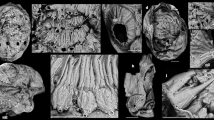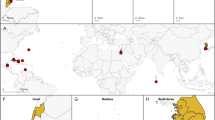Abstract
Xenoturbellida and Acoelomorpha are marine worms with contentious ancestry. Both were originally associated with the flatworms (Platyhelminthes), but molecular data have revised their phylogenetic positions, generally linking Xenoturbellida to the deuterostomes1,2 and positioning the Acoelomorpha as the most basally branching bilaterian group(s)3,4,5,6. Recent phylogenomic data suggested that Xenoturbellida and Acoelomorpha are sister taxa and together constitute an early branch of Bilateria7. Here we assemble three independent data sets—mitochondrial genes, a phylogenomic data set of 38,330 amino-acid positions and new microRNA (miRNA) complements—and show that the position of Acoelomorpha is strongly affected by a long-branch attraction (LBA) artefact. When we minimize LBA we find consistent support for a position of both acoelomorphs and Xenoturbella within the deuterostomes. The most likely phylogeny links Xenoturbella and Acoelomorpha in a clade we call Xenacoelomorpha. The Xenacoelomorpha is the sister group of the Ambulacraria (hemichordates and echinoderms). We show that analyses of miRNA complements8 have been affected by character loss in the acoels and that both groups possess one miRNA and the gene Rsb66 otherwise specific to deuterostomes. In addition, Xenoturbella shares one miRNA with the ambulacrarians, and two with the acoels. This phylogeny makes sense of the shared characteristics of Xenoturbellida and Acoelomorpha, such as ciliary ultrastructure and diffuse nervous system, and implies the loss of various deuterostome characters in the Xenacoelomorpha including coelomic cavities, through gut and gill slits.
This is a preview of subscription content, access via your institution
Access options
Subscribe to this journal
Receive 51 print issues and online access
$199.00 per year
only $3.90 per issue
Buy this article
- Purchase on Springer Link
- Instant access to full article PDF
Prices may be subject to local taxes which are calculated during checkout



Similar content being viewed by others
References
Bourlat, S. et al. Deuterostome phylogeny reveals monophyletic chordates and the new phylum Xenoturbellida. Nature 444, 85–88 (2006)
Bourlat, S., Nielsen, C., Lockyer, A., Littlewood, D. T. J. & Telford, M. J. Xenoturbella is a deuterostome that eats molluscs. Nature 424, 925–928 (2003)
Egger, B. et al. To be or not to be a flatworm: the acoel controversy. PLoS ONE 4, e5502 (2009)
Telford, M. J., Lockyer, A. E., Cartwright-Finch, C. & Littlewood, D. T. J. Combined large and small subunit ribosomal RNA phylogenies support a basal position of the acoelomorph flatworms. Proc. R. Soc. Lond. B 270, 1077–1083 (2003)
Sempere, L. F., Cole, C. N., McPeek, M. A. & Peterson, K. J. The phylogenetic distribution of metazoan microRNAs: insights into evolutionary complexity and constraint. J. Exp. Zool. B 306, 575–588 (2006)
Ruiz Trillo, I., Riutort, M., Littlewood, D. T. J., Herniou, E. A. & Baguñà, J. Acoel flatworms: earliest extant bilaterian metazoans, not members of Platyhelminthes. Science 283, 1919–1923 (1999)
Hejnol, A. et al. Assessing the root of bilaterian animals with scalable phylogenomic methods. Proc. R. Soc. B 276, 4261–4270 (2009)
Sempere, L. F., Martinez, P., Cole, C., Baguñà, J. & Peterson, K. J. Phylogenetic distribution of microRNAs supports the basal position of acoel flatworms and the polyphyly of Platyhelminthes. Evol. Dev. 9, 409–415 (2007)
Ruiz-Trillo, I. et al. A phylogenetic analysis of myosin heavy chain type II sequences corroborates that Acoela and Nemertodermatida are basal bilaterians. Proc. Natl Acad. Sci. USA 99, 11246–11251 (2002)
Bourlat, S. J., Rota-Stabelli, O., Lanfear, R. & Telford, M. J. The mitochondrial genome structure of Xenoturbella bocki (phylum Xenoturbellida) is ancestral within the deuterostomes. BMC Evol. Biol. 9, 107 (2009)
Philippe, H., Brinkmann, H., Martinez, P., Riutort, M. & Baguñà, J. Acoel flatworms are not platyhelminthes: evidence from phylogenomics. PLoS ONE 2, e717 (2007)
Rodríguez-Ezpeleta, N. et al. Detecting and overcoming systematic errors in genome-scale phylogenies. Syst. Biol. 56, 389–399 (2007)
Lartillot, N. & Philippe, H. Improvement of molecular phylogenetic inference and the phylogeny of Bilateria. Phil. Trans. R. Soc. B 363, 1463–1472 (2008)
Ruiz Trillo, I., Riutort, M., Fourcade, H. M., Baguña, J. & Boore, J. Mitochondrial genome data support the basal position of Acoelomorpha and the polyphyly of the Platyhelminthes. Mol. Phyl. Evol. 33, 321–332 (2004)
Papillon, D., Perez, Y., Caubit, X. & Le Parco, Y. Identification of chaetognaths as protostomes is supported by the analysis of their mitochondrial genome. Mol. Biol. Evol. 21, 2122–2129 (2004)
Sperling, E. A. & Peterson, K. J. in Animal Evolution. Genomes, Fossils and Trees (eds Telford, M. J. & Littlewood, D. T. J. ) Ch. 15, 157–170 (Oxford Univ. Press, 2009)
Lundin, K. Degenerating epidermal cells in Xenoturbella bocki (phylum uncertain), Nemertodermatida and Acoela (Platyhelminthes). Belg. J. Zool. 131, 153–157 (2001)
Westblad, E. Xenoturbella bocki n.g, n.sp, a peculiar, primitive turbellarian type. Arkiv Zool 1, 3–29 (1949)
Nielsen, C. After all: Xenoturbella is an acoelomorph!. Evol. Dev. 12, 241–243 (2010)
Franzen, A. & Afzelius, B. A. The ciliated epidermis of Xenoturbella bocki (Platyhelminthes, Xenoturbellida) with some phylogenetic considerations. Zool. Scr. 16, 9–17 (1987)
Pardos, F. Fine structure and function of pharynx cilia in Glossobalanus minutus Kowalewsky (Entropneusta). Acta Zool. 69, 1–12 (1988)
Tyler, S. in Interrelationships of the Platyhelminthes (eds Littlewood, D. T. J. & Bray, R. A. ) 3–12 (Taylor & Francis, 2001)
Telford, M. J. Xenoturbellida: the fourth deuterostome phylum and the diet of worms. Genesis 46, 580–586 (2008)
Baguña, J., Martinez, P., Paps, J. & Riutort, M. Back in time: a new systematic proposal for the Bilateria. Proc. R. Soc. B 363, 1481–1491 (2008)
Hejnol, A. & Martindale, M. Q. M. Acoel development supports a simple planula-like urbilaterian. Phil. Trans. R. Soc. B 363, 1493–1501 (2008)
Peterson, K. J., McPeek, M. A. & Evans, D. A. Tempo and mode of early animal evolution: inferences from rocks, Hox, and molecular clocks. Paleobiology 31, 36–55 (2005)
Ruppert, E. E. Key characters uniting hemichordates and chordates: homologies or homoplasies? Can. J. Zool. 83, 8–23 (2005)
Philippe, H. et al. Phylogenomics revives traditional views on deep animal relationships. Curr. Biol. 19, 706–712 (2009)
Lartillot, N. & Philippe, H. A Bayesian mixture model for across-site heterogeneities in the amino-acid replacement process. Mol. Biol. Evol. 21, 1095–1109 (2004)
Wheeler, B. et al. The deep evolution of metazoan microRNAs. Evol. Dev. 11, 50–68 (2009)
Birney, E., Clamp, M. & Durbin, R. GeneWise and GenomeWise. Genome Res. 14, 988–995 (2004)
Huang, X. & Madan, A. CAP3: a DNA assembly programme. Genome Res. 9, 868–877 (1999)
Abascal, F., Zardoya, R. & Telford, M. J. TranslatorX: multiple alignment of nucleotide sequences guided by amino acid translations. Nucleic Acids Res. 38, W7–W13 (2010)
Jeanmougin, F., Thompson, J. D., Gouy, M., Higgins, D. G. & Gibson, T. J. Multiple sequence alignment with Clustal X. Trends Biochem. Sci. 23, 403–405 (1998)
Dunn, C. W. et al. Broad phylogenomic sampling improves resolution of the animal tree of life. Nature 452, 745–749 (2008)
Philippe, H. MUST, a computer package of management utilities for sequences and trees. Nucleic Acids Res. 21, 5264–5272 (1993)
Castresana, J. Selection of conserved blocks from multiple alignments for their use in phylogenetic analysis. Mol. Biol. Evol. 17, 540–552 (2000)
Roure, B., Rodriguez-Ezpeleta, N. & Philippe, H. SCaFoS: a tool for selection, concatenation and fusion of sequences for phylogenomics. BMC Evol. Biol. 7 (Suppl. 1). S2 (2007)
Schmidt, H. A., Strimmer, K., Vingron, M. & von Haeseler, A. TREE-PUZZLE: maximum likelihood phylogenetic analysis using quartets and parallel computing. Bioinformatics 18, 502–504 (2002)
Lartillot, N., Lepage, T. & Blanquart, S. PhyloBayes 3: a Bayesian software package for phylogenetic reconstruction and molecular dating. Bioinformatics 25, 2286–2288 (2009)
Lartillot, N., Brinkmann, H. & Philippe, H. Suppression of long-branch attraction artefacts in the animal phylogeny using a site-heterogeneous model. BMC Evol. Biol. 7 (Suppl. 1). S4 (2007)
Felsenstein, J. Confidence limits on phylogenies: an approach using the bootstrap. Evolution 39, 783–791 (1985)
Felsenstein, J. PHYLIP (Phylogeny Inference Package) version 3.69 (Department of Genome Sciences, Univ. Washington, Seattle, 2005)
Stamatakis, A. RAxML-VI-HPC: maximum likelihood-based phylogenetic analyses with thousands of taxa and mixed models. Bioinformatics 22, 2688–2690 (2006)
Blanquart, S. & Lartillot, N. A site- and time-heterogeneous model of amino acid replacement. Mol. Biol. Evol. 25, 842–858 (2008)
Hrdy, I. et al. Trichomonas hydrogenosomes contain the NADH dehydrogenase module of mitochondrial complex I. Nature 432, 618–622 (2004)
Roure, B. & Philippe, H. Site-specific time heterogeneity of the substitution process and its impact on phylogenetic inference. BMC Evol. Biol (in the press)
Acknowledgements
We thank N. Lartillot for reading the manuscript, W. Sterrer for helping collect material, and E. Sperling for help with small RNA library construction. H.P. is funded by Canada Research Chairs, Natural Sciences and Engineering Research Council and Réseau Québécois de Calcul de Haute Performance for computational resources: more than 220,000 central processing unit (CPU)–hours were used producing at least 7 tonnes of CO2 excluding grey energy. R.R.C. and M.J.T. were part-funded by the Biotechnology and Biological Sciences Research Council SYNTAX scheme. K.J.P. is supported by the National Science Foundation and NASA Ames. R.R.C. was also supported by a Wellcome Trust core award, grant number 075491/Z/04. A.J.P. was supported by the Max-Planck Society for the Advancement of Sciences e.V. A.W. was funded by Inez Johanssons Stiftelse and Stiftelsen Lars Hiertas Minne.
Author information
Authors and Affiliations
Contributions
H.P. and M.J.T. conceived and designed the study. M.J.T. assembled mitochondrial data. H.P. and H.B. assembled EST data and performed phylogenetic analyses of ESTs and mitochondrial genomes. M.J.T., L.L.M. and R.R.C. performed preliminary phylogenomic analyses. H.N. collected Xenoturbella for genomic and miRNA data. A.W. collected Hofstenia. K.J.P. and A.W. produced Xenoturbella and Hofstenia miRNA libraries. K.J.P. assembled and analysed the miRNA matrix. M.J.T., R.R.C. and A.J.P. produced Xenoturbella genomic data. M.J.T. drafted the paper with H.P. and K.J.P. All authors commented on the manuscript.
Corresponding author
Ethics declarations
Competing interests
The authors declare no competing financial interests.
Additional information
MicroRNA sequences are deposited in http://www.mirbase.org and can be found in the Supplementary Information.
Supplementary information
Supplementary Information
The file contains Supplementary Figures 1-16 with legends and Supplementary Tables 1-3. (PDF 1404 kb)
Supplementary Information
This file contains the aligned and concatenated mitochondrial genes used in phylogenetic analyses. (TXT 66 kb)
Supplementary Information
This file contains the aligned and concatenated nuclear genes used in phylogenetic analyses. (TXT 2471 kb)
Supplementary Information
This file contains the aligned and concatenated nuclear genes used in phylogenetic analyses derived from the data sets of Hejnol et al. (TXT 2262 kb)
Supplementary Information
This file contains the matrix of presence absence for microRNAs used in phylogenetic analyses. (TXT 7 kb)
Rights and permissions
About this article
Cite this article
Philippe, H., Brinkmann, H., Copley, R. et al. Acoelomorph flatworms are deuterostomes related to Xenoturbella. Nature 470, 255–258 (2011). https://doi.org/10.1038/nature09676
Received:
Accepted:
Published:
Issue Date:
DOI: https://doi.org/10.1038/nature09676
This article is cited by
-
Induced spawning with gamete release from body ruptures during reproduction of Xenoturbella bocki
Communications Biology (2023)
-
Acoel single-cell atlas reveals expression dynamics and heterogeneity of adult pluripotent stem cells
Nature Communications (2023)
-
Cholecystokinin/sulfakinin peptide signaling: conserved roles at the intersection between feeding, mating and aggression
Cellular and Molecular Life Sciences (2022)
Comments
By submitting a comment you agree to abide by our Terms and Community Guidelines. If you find something abusive or that does not comply with our terms or guidelines please flag it as inappropriate.



